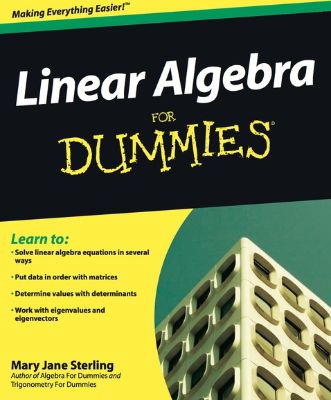
Lýsing:
Learn to: Solve linear algebra equations in several ways Put data in order with matrices Determine values with determinants Work with eigenvalues and eigenvectors Your hands-on guide to real-world applications of linear algebra Does linear algebra leave you feeling lost? No worries —this easy-to-follow guide explains the how and the why of solving linear algebra problems in plain English.
From matrices to vector spaces to linear transformations, you'll understand the key concepts and see how they relate to everything from genetics to nutrition to spotted owl extinction. Line up the basics — discover several different approaches to organizing numbers and equations, and solve systems of equations algebraically or with matrices Relate vectors and linear transformations — link vectors and matrices with linear combinations and seek solutions of homogeneous systems Evaluate determinants — see how to perform the determinant function on different sizes of matrices and take advantage of Cramer's rule Hone your skills with vector spaces — determine the properties of vector spaces and their subspaces and see linear transformation in action Tackle eigenvalues and eigenvectors — define and solve for eigenvalues and eigenvectors and understand how they interact with specific matrices Open the book and find: Theoretical and practical ways of solving linear algebra problems Definitions of terms throughout and in the glossary New ways of looking at operations How linear algebra ties together vectors, matrices, determinants, and linear transformations Ten common mathematical representations of Greek letters Real-world applications of matrices and determinants.
Annað
- Höfundur: Mary Jane Sterling
- Útgáfa:1
- Útgáfudagur: 2009-06-05
- Hægt að prenta út 10 bls.
- Hægt að afrita 2 bls.
- Format:Page Fidelity
- ISBN 13: 9780470538166
- Print ISBN: 9780470430903
- ISBN 10: 0470538163
Efnisyfirlit
- About the Author
- Dedication
- Author’s Acknowledgments
- Contents at a Glance
- Table of Contents
- Introduction
- About This Book
- Conventions Used in This Book
- What You’re Not to Read
- Foolish Assumptions
- How This Book Is Organized
- Icons Used in This Book
- Where to Go from Here
- Part I: Lining Up the Basics of Linear Algebra
- Chapter 1: Putting a Name to Linear Algebra
- Solving Systems of Equations in Every Which Way but Loose
- Matchmaking by Arranging Data in Matrices
- Valuating Vector Spaces
- Determining Values with Determinants
- Zeroing In on Eigenvalues and Eigenvectors
- Chapter 2: The Value of Involving Vectors
- Describing Vectors in the Plane
- Defining the Algebraic and Geometric Properties of Vectors
- Managing a Vector’s Magnitude
- Chapter 3: Mastering Matrices and Matrix Algebra
- Getting Down and Dirty with Matrix Basics
- Putting Matrix Operations on the Schedule
- Putting Labels to the Types of Matrices
- Connecting It All with Matrix Algebra
- Investigating the Inverse of a Matrix
- Chapter 4: Getting Systematic with Systems of Equations
- Investigating Solutions for Systems
- Dealing with Inconsistent Systems and No Solution
- Solving Systems Algebraically
- Revisiting Systems of Equations Using Matrices
- Chapter 1: Putting a Name to Linear Algebra
- Chapter 5: Lining Up Linear Combinations
- Defining Linear Combinations of Vectors
- Getting Your Attention with Span
- Chapter 6: Investigating the Matrix Equation AX=b
- Working Through Matrix-Vector Products
- Confirming the Existence of a Solution or Solutions
- Chapter 7: Homing In on Homogeneous Systems and Linear Independence
- Seeking Solutions of Homogeneous Systems
- Delving Into Linear Independence
- Connecting Everything to Basis
- Chapter 8: Making Changes with Linear Transformations
- Formulating Linear Transformations
- Proposing Properties of Linear Transformations
- Writing the Matrix of a Linear Transformation
- Determining the Kernel and Range of a Linear Transformation
- Chapter 9: Keeping Things in Order with Permutations
- Computing and Investigating Permutations
- Involving Inversions in the Counting
- Chapter 10: Determining Values of Determinants
- Evaluating the Determinants of 2 × 2 Matrices
- Using Determinants with Area and Volume
- Chapter 11: Personalizing the Properties of Determinants
- Transposing and Inverting Determinants
- Interchanging Rows or Columns
- Zeroing In on Zero Determinants
- Manipulating Matrices by Multiplying and Combining
- Taking on Upper or Lower Triangular Matrices
- Determinants of Matrix Products
- Chapter 12: Taking Advantage of Cramer’s Rule
- Inviting Inverses to the Party with Determined Determinants
- Solving Systems Using Cramer’s Rule
- Recognizing and Dealing with a Nonanswer
- Making a Case for Calculators and Computer Programs
- Chapter 13: Promoting the Properties of Vector Spaces
- Delving into the Vector Space
- Describing the Two Operations
- Singling Out the Specifics of Vector Space Properties
- Chapter 14: Seeking Out Subspaces of a Vector Space
- Investigating Properties Associated with Subspaces
- Finding a Spanning Set for a Vector Space
- Defining and Using the Column Space
- Connecting Null Space and Column Space
- Chapter 15: Scoring Big with Vector Space Bases
- Going Geometric with Vector Spaces
- Creating Bases from Spanning Sets
- Making the Right Moves with Orthogonal Bases
- Writing the Same Vector after Changing Bases
- Chapter 16: Eyeing Eigenvalues and Eigenvectors
- Defining Eigenvalues and Eigenvectors
- Solving for Eigenvalues and Eigenvectors
- Circling Around Special Circumstances
- Getting It Straight with Diagonalization
- Chapter 17: Ten Real-World Applications Using Matrices
- Controlling Traffic
- Catching Up with Predator-Prey
- Creating a Secret Message
- Saving the Spotted Owl
- Migrating Populations
- Plotting Genetic Code
- Distributing the Heat
- Making Economical Plans
- Playing Games with Matrices
- Eating Right
- Chapter 18: Ten (Or So) Linear Algebra Processes You Can Do on Your Calculator
- Letting the Graph of Lines Solve a System of Equations
- Making the Most of Matrices
- Performing Row Operations
- Raising to Powers and Finding Inverses
- Determining the Results of a Markov Chain
- Solving Systems Using A–1*B
- Adjusting for a Particular Place Value
- Chapter 19: Ten Mathematical Meanings of Greek Letters
- Insisting That π Are Round
- Determining the Difference with Δ
- Summing It Up with Σ
- Row, Row, Row Your Boat with ρ
- Taking on Angles with θ
- Looking for a Little Variation with ε
- Taking a Moment with μ
- Looking for Mary’s Little λ
- Wearing Your ΦΒΚ Key
- Coming to the End with ω
UM RAFBÆKUR Á HEIMKAUP.IS
Bókahillan þín er þitt svæði og þar eru bækurnar þínar geymdar. Þú kemst í bókahilluna þína hvar og hvenær sem er í tölvu eða snjalltæki. Einfalt og þægilegt!Rafbók til eignar
Rafbók til eignar þarf að hlaða niður á þau tæki sem þú vilt nota innan eins árs frá því bókin er keypt.
Þú kemst í bækurnar hvar sem er
Þú getur nálgast allar raf(skóla)bækurnar þínar á einu augabragði, hvar og hvenær sem er í bókahillunni þinni. Engin taska, enginn kyndill og ekkert vesen (hvað þá yfirvigt).
Auðvelt að fletta og leita
Þú getur flakkað milli síðna og kafla eins og þér hentar best og farið beint í ákveðna kafla úr efnisyfirlitinu. Í leitinni finnur þú orð, kafla eða síður í einum smelli.
Glósur og yfirstrikanir
Þú getur auðkennt textabrot með mismunandi litum og skrifað glósur að vild í rafbókina. Þú getur jafnvel séð glósur og yfirstrikanir hjá bekkjarsystkinum og kennara ef þeir leyfa það. Allt á einum stað.
Hvað viltu sjá? / Þú ræður hvernig síðan lítur út
Þú lagar síðuna að þínum þörfum. Stækkaðu eða minnkaðu myndir og texta með multi-level zoom til að sjá síðuna eins og þér hentar best í þínu námi.
Fleiri góðir kostir
- Þú getur prentað síður úr bókinni (innan þeirra marka sem útgefandinn setur)
- Möguleiki á tengingu við annað stafrænt og gagnvirkt efni, svo sem myndbönd eða spurningar úr efninu
- Auðvelt að afrita og líma efni/texta fyrir t.d. heimaverkefni eða ritgerðir
- Styður tækni sem hjálpar nemendum með sjón- eða heyrnarskerðingu
- Gerð : 208
- Höfundur : 10694
- Útgáfuár : 2009


